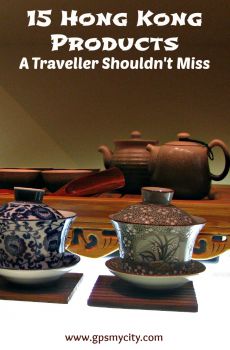
15 Hong Kong Products A Traveller Shouldn't Miss
1. Jade
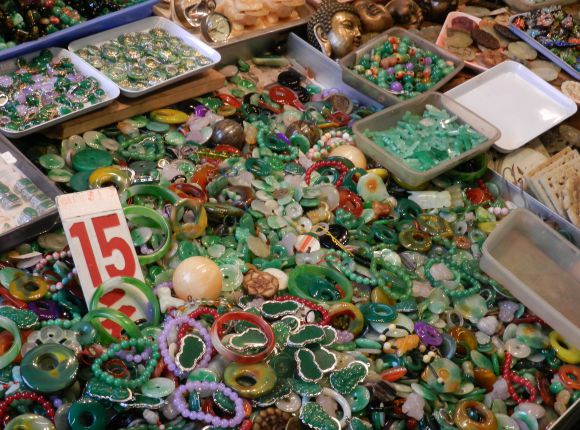
Top quality jade is pure green and very expensive. Most pieces can have a yellow tinge, but the finished item should be devoid of brown or grey. The best jade is semi-transparent, while opaque jade with cloudy patches tends to be of less value. The Chinese character for jade translates to "beauty" and "purity". The stone symbolizes long life and good health, as such, many traditionalists wear jade to guard against illnesses.
The Jade Market is located on Kansu and Battery Streets in Jordan. Opening hours vary between the 400 vendors, but the Market is typically open daily, 9am-5:30pm. Jade Street is nearby, located on Canton Road between Kansu Street and Jordan Road. Shops on this street operate Monday to Saturday, from 10am-4pm. A giant jade stone that weighs three tons acts as a landmark at the junction of Canton Road and Jordan Road.
2. Original ChineseTea

Tea can be bought anywhere in Hong Kong, but tourists flock to Ying Kee Tea House for their dim sum and tea fix. Dating from 1881, Ying Kee has become synonymous with quality tea leaves that transport well. This fourth-generation operation offers a diversity of teas, ranging from the typical black, green and white variety to the atypical for the Western palate, slimming and foggy teas. Tea prices vary with quality, ranging from HK$6 an ounce to HK$18,000 for a patty. Ying Kee also offers tea sets and utensils for the enthusiasts who want to have traditional tea parties back at home. Ying Kee has 13 boutiques scattered through the major districts of Hong Kong, on Hong Kong Island, in Kowloon and the New Territories.
3. Chinese Mailbox
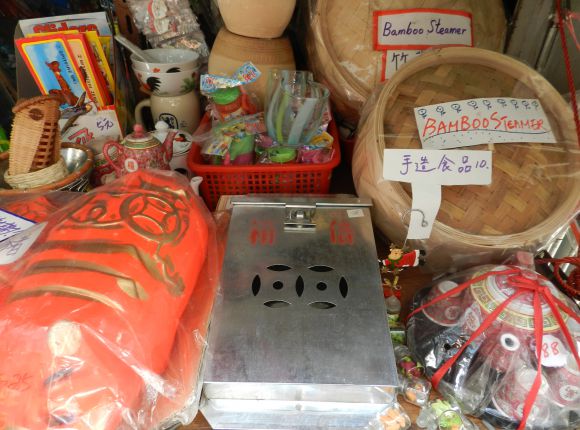
These antique mailboxes can be found along Tai O Wing On Street in a non-assuming haberdashery, called Wing On Department Store. Not to be confused with the giant department store, this mini-version is a family-owned business. With indeterminate opening hours that cater to the tourist season, shoppers can find the store open during peak tourist times and in accord with the bus schedule.
211 Des Voeux Road Central, Hong Kong
+852 2852 1888
4. Shrimp Paste

Hong Kong shrimp paste comes in jars of varying sizes and varying prices. Small jars retail for HK$22, medium for HK$27, and large for HK$32. Gift packs are available and packaged accordingly with decorative packaging that fits easily into suitcases. Shrimp paste companies in these coastal villages are small family-owned operations that date back to over 60 years in the industry.
The best places to purchase high-quality shrimp paste are coastal villages. Thusly, the fishing village Tai O boasts Hong Kong’s best shrimp paste. Two famous producers are located blocks apart. Yick Cheong Seafood Company dates back to over 60 years. Their shrimp paste is made daily in the shop’s adjoining kitchen. Their hours of operation are 9am-6pm daily and they are located at 44-48 Wong On Street, Tai O. Another producer is Cheung Choi Kee with over 40 years on the market. Their shrimp paste is also made in an adjoining family kitchen. Their hours of operation are 7am-6pm daily and they can be found at 41 Kat Hing Front Street, Tai O.
29855312
5. Pinwheels
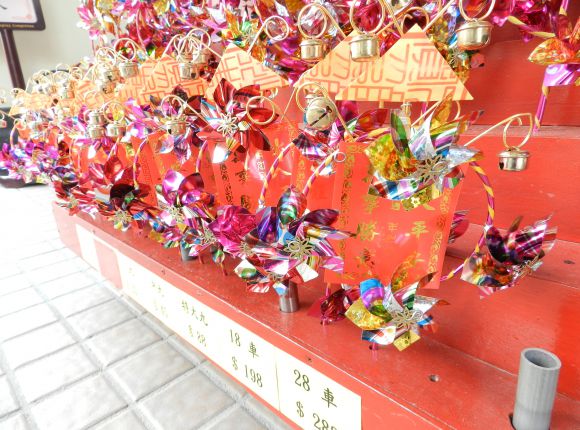
The pinwheels range in size, according to the number of wheels, and the costs also alter in accordance. 4 wheels retail for HK$25, 9 wheels for HK$35-$88, 18 wheels for HK$198, and 28 wheels retail for HK$288. Bells adjoin the pinwheel to ring in the Chinese New Year. Pinwheels are mainly red, as the colour carries a largely positive connotation: courage, loyalty, honour, success, fortune, fertility, happiness and passion.
The Che Kung Temple is located near Tai Wai, in Sha Tin District, New Territories. The temple is open from 7am-6pm daily for worshippers and tourists. Built in 1993, this temple replaced the original Che Kung Temple that dated back to the Ming Dynasty. Admission to the temple is free, but it is customary for visitors to donate money to support the temple maintenance.
6. Temple Charms
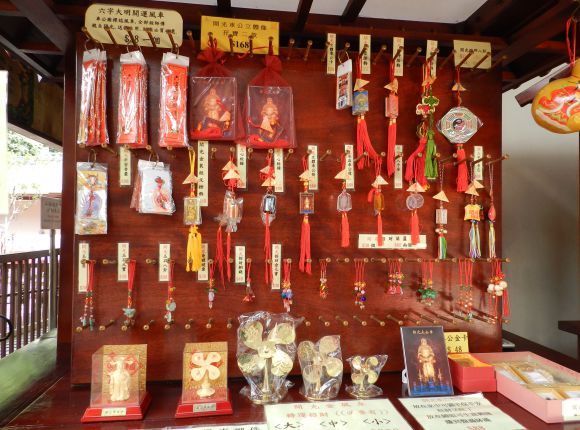
These charms are popular with tourists and locals alike to ward off bad luck and welcome the good. Charms come in an assortment of designs and prosperous wishes. Whether a believer or not, these charms are compact, affordable and a reminder of ancient traditions. Popular charms involve the Chinese zodiac and cost HK$38. Safety and well-wishes charms range from HK$18-88. Jade charms can cost as much as $268.
Most temples offer charms with varying designs, costs and effectiveness, but famous temples tend to offer more variety and be more effective. The Che Kung Temple, located near Tai Wai, in Sha Tin District, New Territories, is one of the most famous temples in Hong Kong, and offers such charms at tourist prices. The temple is open from 7am-6pm daily for worshippers and tourists. Admission to the temple is free, but it is customary for visitors to donate money to support the maintenance of the temple.
7. McMug (Animation)
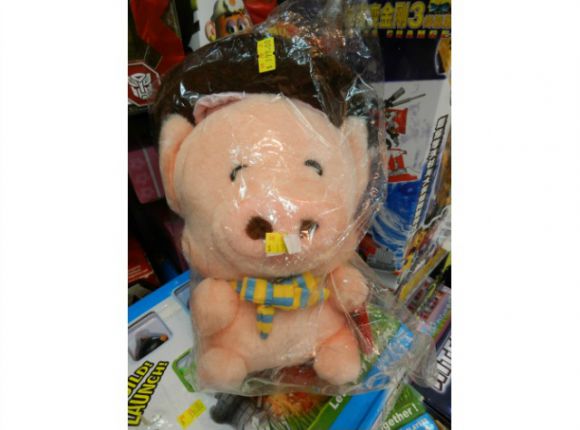.jpg)
The character and his family and friends are renowned in Hong Kong and overseas Chinese communities. McMug’s popularity has waned in recent years, but his iconic stature is still heavily regarded. At its peak, the characters appeared in books, movies, television programmes, stationary, home appliances and other commodities. McMug merchandise can still be found everywhere and its songs sung throughout the streets. McMug memorabilia can be found throughout Hong Kong. Major department stores carry McMug merchandise and are the safest places to buy the real-deal. A notable department store, that carries McMug, is Apita. The popular McMug dolls can be found in the children’s department in any of the three branches: Apita Tai Koo, Cityplaza 2, 18 Taikoo Shing Road, Quarry Bay, open from 10am-10:30pm; UNY Lok Fu, Level 2-3, Lok Fu Plaza, Lok Fu Estate, No. 198 Junction Road, Kowloon, open 10am-10pm; and PIAGO Kowloon Bay, shop 401-402 & 501-502, Telford Plaza II, Kowloon Bay, open 10am-10pm.
Quarry Bay
UNY Lok Fu, Level 2-3, Lok Fu Plaza, Lok Fu Estate,
No. 198 Junction Road, Kowloon
PIAGO Kowloon Bay, shop 401-402 &
501-502, Telford Plaza II, Kowloon Bay
8. Asiatic Houseware

Hot designers are creating pieces and housewares to fit this trend, and one of the easiest places to find them in one location is G.O.D. Founded in 1996 by Douglas Young and Benjamin Lau, G.O.D. (Goods of Desire) is a concept store that capitalises on the recent trend for Chinese-inspired merchandise. G.O.D. integrates tradition with modernity, taking inspiration from historic and current-day Hong Kong culture. Specialising in housewares and furnishings, they update Oriental traditions and designs to cater to the modern home and lifestyle. Their lifestyle products run the gamut from home accessories to furniture to fashion. Their most famous home accessory design is the Chinese “Double Happiness” character collection, which ranges from bedding to table decor, such as candles. Also famous for furnishings, G.O.D.’s major products utilise bamboo and traditional Chinese materials and motifs in tables, beds, cabinets and more.
G.O.D. items are not for those on a shoestring budget. Wares can range from a Chinese-character candle for HK$75 to coffee tables for HK$6790 and above, depending on the furnishing. However, their designs that push the envelope on Chinese traditions are still highly popular with expatriates and modernists. G.O.D. boasts five stores in Hong Kong. The original store in Ap Lei Chau is defunct in lieu of the flagship store in Causeway Bay and their 4 other central locations in Central, Tsim Sha Tsui, Shek Kip Mei and The Peak Galleria. Each location has varying opening hours. The flagship store, located on Sharp Street, East Entrance, Causeway Bay, is open daily from noon-10pm.
30 Canton Road, Hong Kong
9. Garden (Brand)
.jpg)
Their famous Pop Pan Crackers have remained popular with children and adults throughout the years. Pop Pan Crackers now come in a variety of flavours, but their original, spring onion flavour still flies off the shelves. The crackers come in two rows of crispy goodness that have the magical ability to remain crisp for weeks, especially the more magical given Hong Kong’s humidity. A box of Pop Pans typically retail for HK$12.90. Invest in a few boxes for the flight home or there may not be any left for souvenirs. Found in every supermarket, convenience store, canteen and mom-and-pop shop, Pop Pans and most Garden items are easy to purchase. The most economical place to buy them would be supermarkets. Wellcome is the most economical supermarket in Hong Kong and its 257 locations can be found throughout the city. Opening hours are typically 8am-10/11pm, depending on the branch.
10. Soy Milk
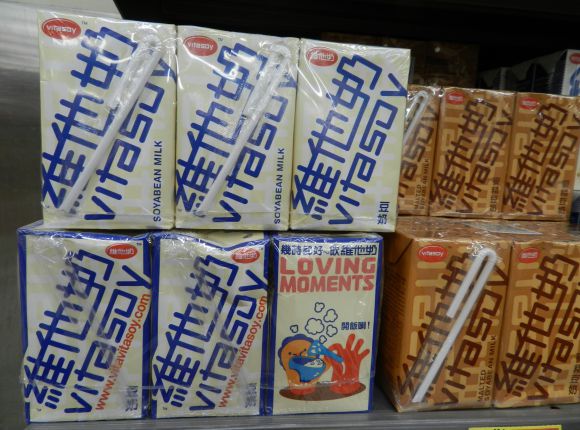
Its current package is a soy off-white coloured carton with blue lettering. Different package options include glass bottles, PET bottles, Tetrapak boxes and aluminium cans. Glass bottles were recently brought back in vogue after its disappearance for many years. A warm version in a glass bottle is available for ready-consumption in convenience stores, harkening back to bygone days when the beverage was heated. Those opting for this souvenir should choose easier packaging to carry. A package of 6 Tetrapak boxes can cost HK$25.10. Taste-wise, traditionalists enjoy the heavily-sugared soy beverage, while the more health-conscious opt for the newer reduced-sugar option. Found in every supermarket, convenience store, canteen, local café and mom-and-pop shop, Vitasoy is easy to purchase. The most economical place to buy them would be supermarkets. Wellcome is the most economical supermarket in Hong Kong and its 257 locations can be found throughout the city. Opening hours are typically 8am-10/11pm, depending on the branch.
11. Street Art
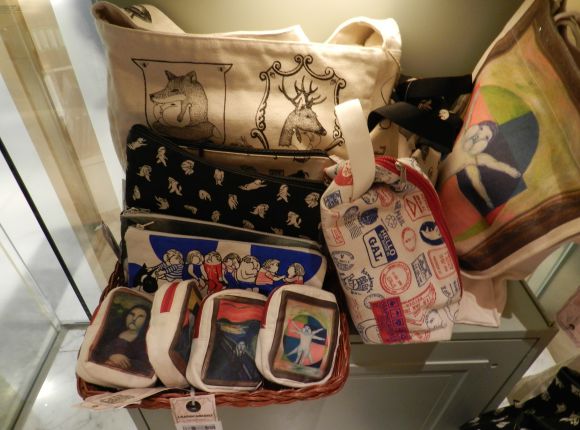
Founded in 2002, GraphicAirlines is the brainchild of the creative Hong Kong duo, TAT and VI. Advocates of the burgeoning Hong Kong street art scene, GraphicAirlines caters to the “aesthetics of ugly,” finding art in the unorthodox. Best known for their t-shirts and bags, which sport the “Fat Face” character, GraphicAirlines has expanded their iconic character to jewellery and other easily portable merchandise.
Their iconic Fat Face character is aptly named. Its cheeks puff out, reminiscent of Buddha, replete with bulging stomach and folds of fat. Unlike Buddha, Fat Face is stylishly clothed in urban streetwear, fittingly printed on urban wear. Colourful in design and character, this aesthetic has taken the street art scene by storm. Its graffiti can be found dotting Hong Kong in a brilliant marketing strategy that caters to street artists. Depending on the store, bags can retail for HK$200 and up. Clothing can range from HK$150 for a tee-shirt to HK$300 for hoodies. GraphicAirlines can be found in many local galleries and independent vendors.
12. Kitsch Merchandise
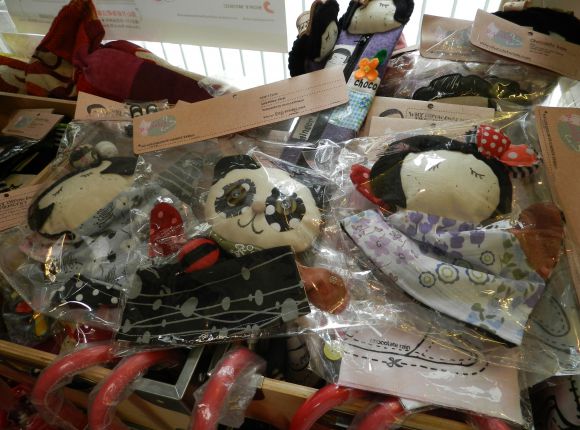
Established in 2003, Chocolate Rain is the mastermind of Hong Kong designer, Prudence Mak. Each piece is a uniquely handcrafted design of childhood whimsy and adult nostalgia for such carefree moments. Best known for its handcrafted dolls and knickknacks, Chocolate Rain has expanded to bags and totes that are sported by many of Hong Kong’s youth. The images printed on Chocolate Rain merchandise recall childhood dreams and, as such, each colourful picture is highly fantastical with walking toys and towering mushrooms.
DIY Workshops are open to the public for them to create their own handmade pieces of Chocolate Rain designs. Workshops are HK$800 for 2 classes or $1250 for four, crafts include hat-making, jewellery creation, beadwork and doll making. Products for purchase include its renowned handmade dolls that start from HK$100 and up. Bags and totes can cost from HK$390, for a basic canvas, to a shoulder bag for HK$480. Chocolate Rain has been exhibited internationally, including the MoMA, Tate Modern and Guggenheim Museum. Its flagship store can be found on HK Island at G/F, 64A Chung Hing Court, Peel Street, Soho, Central. The flagship store is also the location of the DIY workshops and is open daily from 1pm-10pm.
Court, Peel Street, Soho, Central
13. Mooncakes
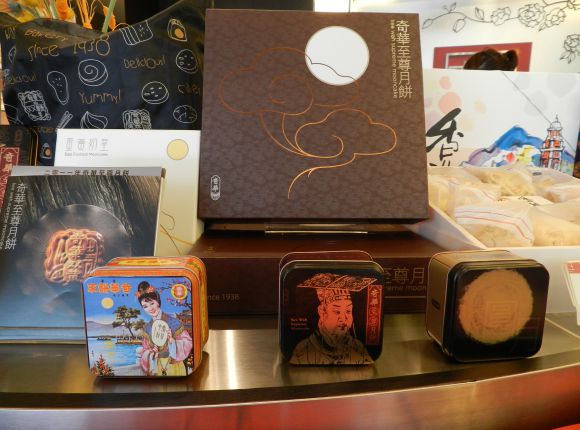
One of the most famous bakeries for mooncakes, as well as other traditional Hong Kong baked items, is Kee Wah. Kee Wah is a family-operated bakery that has expanded to national proportions since its inception over 70 years ago. It specialises in traditional Hong Kong pastries, such as mooncakes, bridal cakes, egg rolls and more. Kee Wah is the all-in-one shop for a taste of old Hong Kong snacks and is the go-to store for mooncakes and bridal cakes. A tin of 4 Kee Wah mooncakes retails for HK$228.
Kee Wah has evolved from its beginnings as a small neighbourhood grocery store on Shanghai Street in Yau Ma Tei. With 48 locations throughout Hong Kong, Kee Wah has expanded its operations to make it easier for tourists and locals to purchase a taste of old Hong Kong. The original store is long gone, but visitors can purchase traditional Hong Kong baked goods in their two airport terminal locations: Terminal 1 – Unit 7T095, Level 7, Terminal 1, Hong Kong International Airport, open 7am-11pm; and Sky Plaza – Unit 5P034, Terminal 2 (Sky Plaza), Hong Kong International Airport, open 8am-11pm.
Shop TST 10, Tsim Sha Tsui MTR Station, Tsim Sha Tsui, Hong Kong
14. Hong Kong Beer
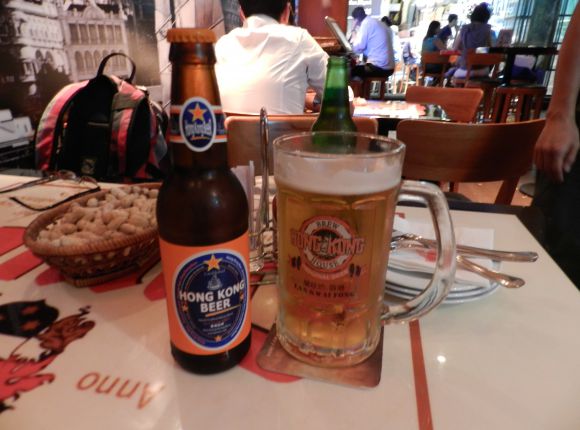
Hong Kong Beer is handcrafted based on a traditional German lager recipe. The recipe calls for a single type barley brewing malt, Hallertau hops and Weihenstephan yeast to form the basis of this beer. Beer aficionados may know what these ingredients mean, but for the rest of us, it brews down to a tawny pale beer with a long bitter aftertaste. It has a smooth body and a light fruity aroma that belies its hard-to-acquire taste. At 4.5%, it will take quite a few to fall the average man. This beer can only be bought in select pubs at HK$47 a bottle.
The brewery is located on Hong Kong Island and is open to the public at Hong Kong Beer Limited, Unit A1, 1/F, Vita Tower, 29 Wong Chuk Hang Road, Aberdeen. For beer enthusiasts, this local brew can be tried in Hong Kong Brew House, Lan Kwai Fong, LG/F, LKF Tower, 33 Wyndham Street, Central, from 11am-2am (Mon-Thurs) 11am-4am (Fri-Sat) and 11am-1am (Sun).
Limited, Unit A1, 1/F, Vita Tower, 29 Wong Chuk Hang Road, Aberdeen.
Hong Kong Brew House, Lan Kwai Fong, LG/F, LKF Tower, 33 Wyndham
Street, Central
HONG KONG BREW HOUSE
Lan Kwai Fong, D'Aguilar Street, Central, Hong Kong
+852 3582 6335
15. Goji Berry

Goji berries are one of the most affordable health supplements in Hong Kong and can retail for HK$40-HK$80 a bag, depending on the volume. Found in all herbal stores throughout the city, goji berries are readily available for health enthusiasts. A notable street with store-upon-store of goji berry availability is Wing Lok Street in Sheung Wan. This street is one of the major arteries for dried foods, ranging from seafood to herbs. Notable shops include: Wah Cheong, 204 Wing Lok Street, open 9am-7pm; and Wing Sing Sum, 130 Wing Lok Street, open 9:30am-7pm.
Wing Sing Sum, 130 Wing Lok Street
Other Interesting Souvenirs from Hong Kong
If traveling to Hong Kong is not an option for you right now, or you simply can't afford extra space in your luggage, fortunately, these days, you can find a wide selection of authentic and truly interesting Cantonese souvenirs online. Presented here are some of the Cantonese products sought by foreign visitors, now available online for your convenience.
2. Chinese Silk Dresses - Women's garments made in traditional Chinese style, including Mandarin collar, fastenings and hem cut. Great attire for a charming lady dressed up for the occasion: Prom, Club, Party, Evening, etc.
3. Paper Cutting Punch Machines -Colorful little things designed for cutting paper in various shapes. A perfect souvenir from Hong Kong for the young ones with a good sense of creativity.
4. Chinese Porcelain - The word “china” denotes both, the home-country of porcelain and porcelain itself, hence, bringing some porcelain from China is a sensible thing to do. And given that China is big on tea much as it is on porcelain, a set of teacups or teapots seems like an obvious choice.
5. Feng Shui Items - If you're an ardent Feng Shui practitioner and duly follow the rules of this ancient Chinese tradition to arrange things in your home to attain a perfect harmony, then perhaps adding a few finishing touches to it, in the form of cute Feng Shui figurines or artifacts, will be right.
Walking Tours in Hong Kong, Hong Kong
Create Your Own Walk in Hong Kong
Colonial Buildings in Central Hong Kong
The Flagstaff House Museum of Tea Ware is one such charming colonial edifice that once served as the residence of the Commander of the British forces. Today, it houses a... view more
Tour Duration: 2 Hour(s)
Travel Distance: 2.5 Km or 1.6 Miles
Causeway Bay Walking Tour
The foremost among its landmarks is Times Square. Despite the name,... view more
Tour Duration: 1 Hour(s)
Travel Distance: 2.8 Km or 1.7 Miles
Kowloon Walking Tour
Some of the top attractions in Kowloon are set around the dazzling Nathan Road (a... view more
Tour Duration: 2 Hour(s)
Travel Distance: 4.6 Km or 2.9 Miles


























